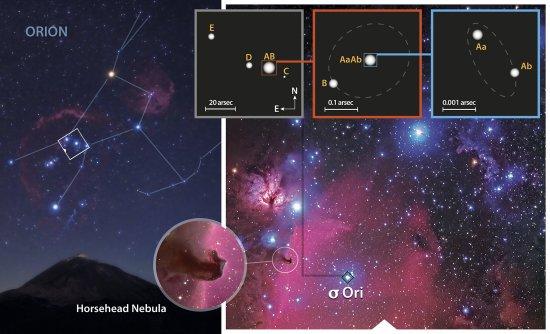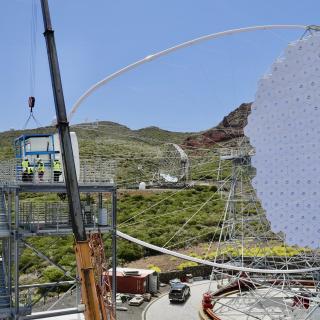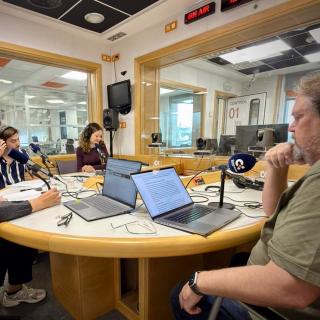Some three million years ago hundreds of stars formed from a dense cloud of gas and dust in the constellation of Orion (“the Hunter”). The star which swallowed the largest part of the mass was sigma Orionis (sigma Ori), which is now the fourth brightest star in the belt of Orion, and which illuminates the famous Horsehead Nebula. At the same time as sigma Orionis, a large number of stars with a full range of masses formed in its neighbourhood, as well as brown dwarfs, and “rogue” planets (objects similar in mass to that of a Jupiter but which do not rotate around a star, rather they move freely in the star cluster). The smallest objects in Orion´s belt have 10,000 times less mass than sigma Orionis.
To understand the frequency of the birth of low mass stars, brown dwarfs, and rogue planets, and how they evolve, we need first to know what happens to their high mass, blue neighbours. With this in mind, an international team of astronomers led by the Spanish researchers Sergio Simón-Díaz, of the Instituto de Astrofísica de Canarias(IAC)/Universidad de La Laguna (ULL), Jose A. Caballero, of the Centro de Astrobiología (CAB, CSIC-INTA), and Javier Lorenzo, of the University of Alicante, have studied in great detail the multiple star sigma Orionis, which continues to amaze those who observe it. The results of this study are published today in the Astrophysical Journal.
FURTHER INFORMATION
A stellar banquet
Paraphrasing Dr. Eldon Tyrell, in Ridley Scott´s film Blade Runner (1982) “a light which shines a thousand times more brightly lasts one thousandth of the time”. This is just what happens in the Universe, the stars which are very, very luminous, with large diameters, high temperatures, and big masses die via supernova explosions when they are only a few million years old, while the stars with low masses have a quiet, long life, comparable with the age of the Universe, which gives time for life to develop on the planets which rotate around them.
Even eons after their deaths one can observe the unique imprint of high mass stars on almost everything around them: our own chemical composition, the distribution in space of the stars and the nebulae which they leave behind after they have exploded, the form of the spiral arms of the galaxies, and even, curiously enough, the number of low mass stars. “This latter effect –explains Sergio Simón-Díaz, who is first author on the paper- is due to the fact that low mass stars, and brown dwarfs (which are objects with masses between those of the smallest stars and the largest planets) are just the left-overs from the banquets of high mass stars”.
The star sigma Orionis is 3 million years old and has a high temperature: its surface temperature is 30,000K five times hotter than that of the Sun. This very high temperature makes the star have a blueish colour, in contrast to less massive stars which have reddish colours. “In 2011 –remembers Caballero- we showed that sigma Orionis is a multiple star consisting of six stars instead of five, as previously thought: two of them are very high mass stars, which are very close together, rotating mutually around each other, a system known as a spectroscopic binary, with an orbital period of some 143 days. A third star, also massive, is orbiting at 100 astronomical units (100 times the distance from the Earth to the Sun) from the other two, and rotates with a much longer period, of some 157 years. The cluster is completed by three other stars, a little cooler and less massive, as well as numerous stellar remnants”.
Now these researchers, together with 11 others from Spain, Germany, Chile, the USA, Belgium, and Hungary, have observed in more detail the central trio of these stars, (sigma Ori Aa, sigma Ori Ab, and sigma Ori B), and have measured their physical parameters with unprecedented accuracy. “ The period of the closest pair, of around 143 days, has now been determined with an inaccuracy of only 11 minutes -points Simón-Díaz-, which makes it feasible to programme specific observations at certain phases, for example with X-ray telescopes in space at periastron, the point where the two central stars are separated by their smallest distance”.
“Gobblers” stars
The study has also allowed us to determine very accurately the masses of the three stars using three different methods. “The sum of the masses of the trio is bigger than 40 times the mass of the Sun”, emphasizes Simón-Díaz. “These observations, together with interferometric observations now in progress, are an excellent input to theoretical modes which aim at explaining the structure and the fate of these “gobbler stars”.
“We have also measured –adds Caballero- the rate of emission of high energy photons from the trio. These photons, emitted by sigma Orionis Aa, Ab, and B and those which ‘comb the mane’ of the Horsehead Nebula, and announce the start of a new banquet of high mass stars in the region. In just a few million years, when sigma Orionis Aa (and perhaps Ab) explode as a supernova, and cleans out the region around it, a large number of smaller, cooler stars will continue to exist, as well as a few large, massive, very hot stars, which at the present moment are inside the dense clouds near the Horsehead Nebula”. And the life cycle of the stars will carry on!
Scientific publication: "Orbital and physical properties of the sigma Ori Aa,Ab,B triple system", Simón-Díaz et al. (2015, ApJ 799, 169)
Contacts:
Sergio Simón Díaz (IAC/ULL): 922 60 55 16
José Antonio Caballero (CAB): 91 813 15 06
Animation /preview:
Title: The sigma Ori Aa,Ab,B, triple system in the Orion's belt
Description: Zooming into the core of the sigma Orionis cluster (from the Orion constellation to the sigma Ori Aa,Ab,B triple system).
Credits: Gabriel Pérez (SMM, IAC) and Sergio Simón Díaz (IAC/ULL), from a composition of images by Luis Chinarro (IAC, Orion & Teide), Daniel López (IAC, Orion's belt region), Nigel Sharp (NOAO, NSF, AURA, Horsehead nebula).



